Garden Ideas to Keep Deer Out: Simple and Effective Solutions
If you’re tired of finding your beautiful garden raided by deer, you’re not alone. Many gardeners struggle with these persistent visitors who can munch their way through your hard work in no time. There are various strategies you can use to keep deer out of your garden and protect your precious plants.
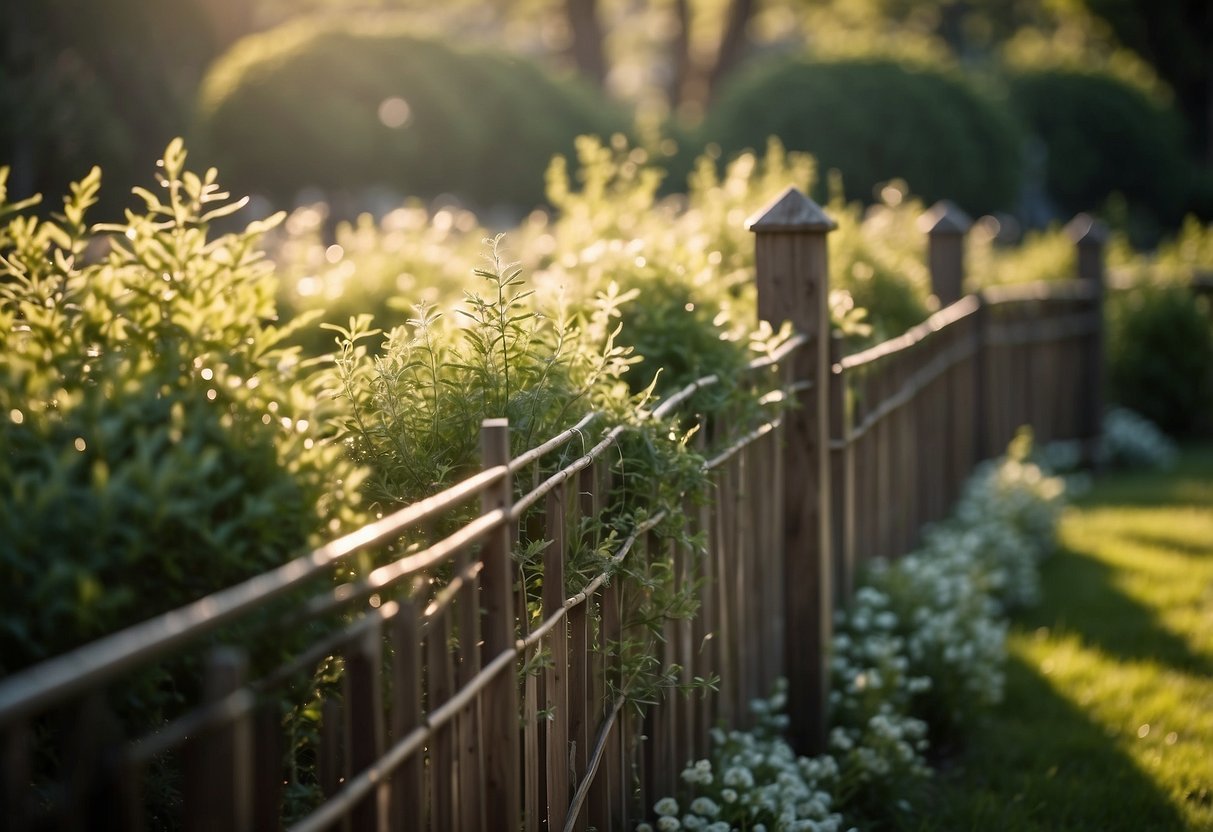
From simple home remedies to professional solutions, you’ll discover numerous ways to safeguard your garden. In this article, we’ll explore a variety of effective and humane methods to make your garden less attractive to deer. By implementing a few of these tips, you can enjoy a deer-free garden and watch your plants thrive.
1) Plant Deer-Repellent Plants

You can keep deer out of your garden by planting certain types of plants they don’t like. For example, foxgloves are easy to grow and their tall flower spikes can add beauty to your garden.
Another option is bee balm. It has a strong fragrance that deer don’t enjoy. This plant also attracts pollinators, which is great for your garden.
By choosing plants like these, you can protect your garden from unwanted visitors.
2) Install a Deer Fence

Start by selecting the right material for your deer fence. A good option is metal wire coated in black polyethylene as it blends into the landscape and is weather-resistant.
Drive sleeves into the ground until they’re flush, then add the posts. Begin attaching the fence from the bottom and work your way up. Leave 4-6 inches of slack for uneven ground.
Make sure the fence is at least 8 feet tall to effectively deter deer. Proper installation will help keep your garden safe from unwanted wildlife. For more details, visit this guide on installing a deer fence.
3) Use Motion-Activated Sprinklers

Motion-activated sprinklers are a great way to keep deer out of your garden. These devices use sensors to detect movement and spray water when deer get close.
The sudden spray of water surprises the deer, making them less likely to return. It’s a humane and safe method to protect your plants.
Check out motion-activated sprinklers at your local garden center or online. They’re easy to set up and require minimal maintenance.
4) Apply Deer Repellent Sprays

You can make your own deer repellent spray with ingredients like vinegar, essential oils, garlic, or hot peppers.
For example, mix white vinegar and essential oils in a spray bottle. A few drops of peppermint and rosemary oil will do the trick.
Another option is to mix garlic or hot pepper with water and a little dish soap. This makes a strong-smelling spray that deer dislike.
Shake well and spray around your garden to keep those deer away!
5) Set Up Noise Makers
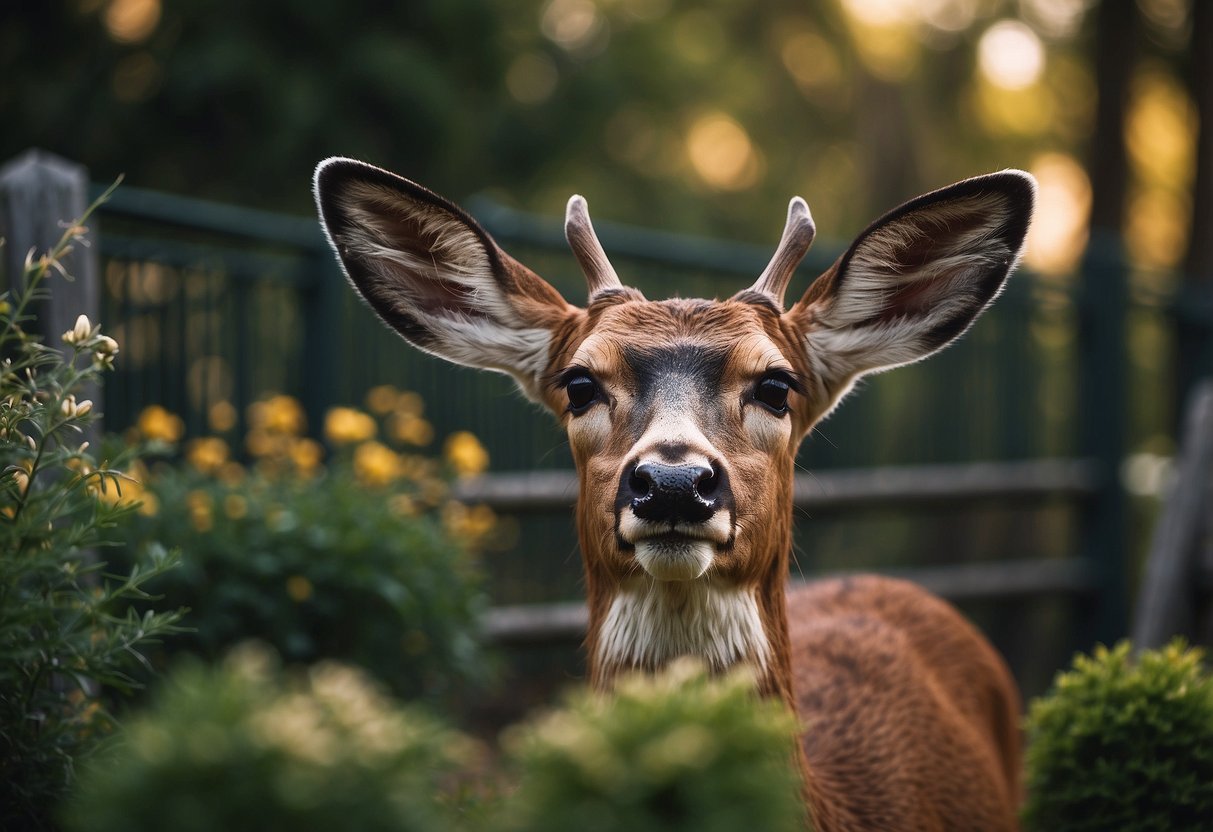
Deer are easily scared by unfamiliar sounds. Try hanging strings of old CDs from tree branches. The noise they make when they bang together can be enough to keep deer away.
Wind chimes work well, too. Choose metal ones for a louder sound. You can hang them around your garden to create a noisy barrier.
Motion sensor alarms are another option. These devices will go off when deer come nearby, frightening them away.
6) Introduce a Guard Dog

Having a guard dog can be an excellent way to keep deer out of your garden. Dogs naturally deter deer because their presence and barking scare them away.
Choose a breed that is known for being alert and territorial. Ensure your dog is trained to stay within your property.
Regularly let your dog roam the garden, especially during dawn and dusk when deer are most active. This will help reinforce the idea that your garden is not a safe haven for deer.
7) Use Reflective Tape

Hanging reflective tape around your garden can keep deer away. The shiny surface catches light and creates flashes that scare deer from entering.
You can attach the tape to poles or hang it from tree branches. It will move with the wind, making it even more effective at startling deer.
For an easy and cost-effective solution, try using reflective tape. It’s simple to set up and doesn’t harm your garden.
8) Plant Thorny Bushes
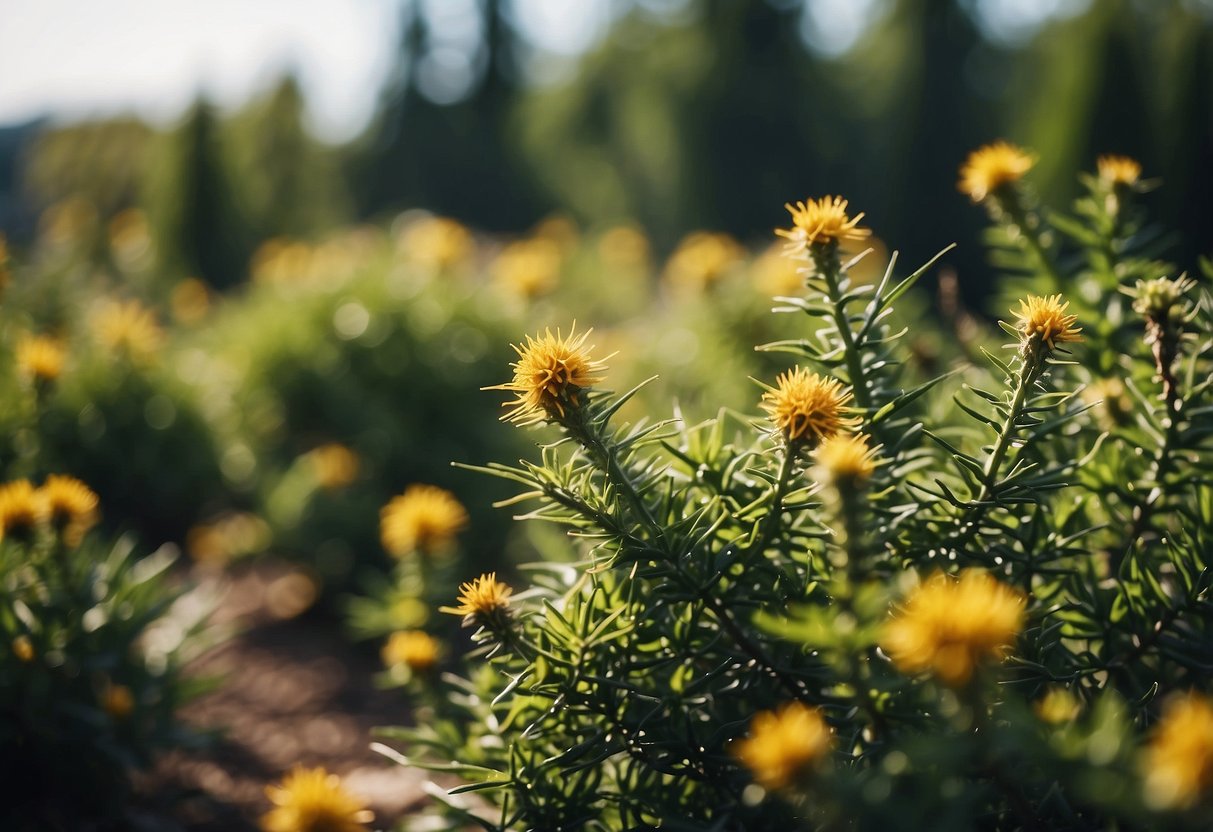
Planting thorny bushes is a natural way to keep deer out of your garden. Bushes like sea buckthorn and barberry have sharp thorns that deter deer and other unwanted animals.
Thorny hedges add a layer of security to your garden. They can also be visually appealing with their colorful berries and unique foliage. Consider using black hawthorn, which attracts birds but keeps deer away.
Bushes with thorns provide both protection and beauty. They require low maintenance and can grow well in various conditions. You can explore options like firethorn and hawthorn for added variety and effectiveness in keeping deer out.
9) Install Garden Netting
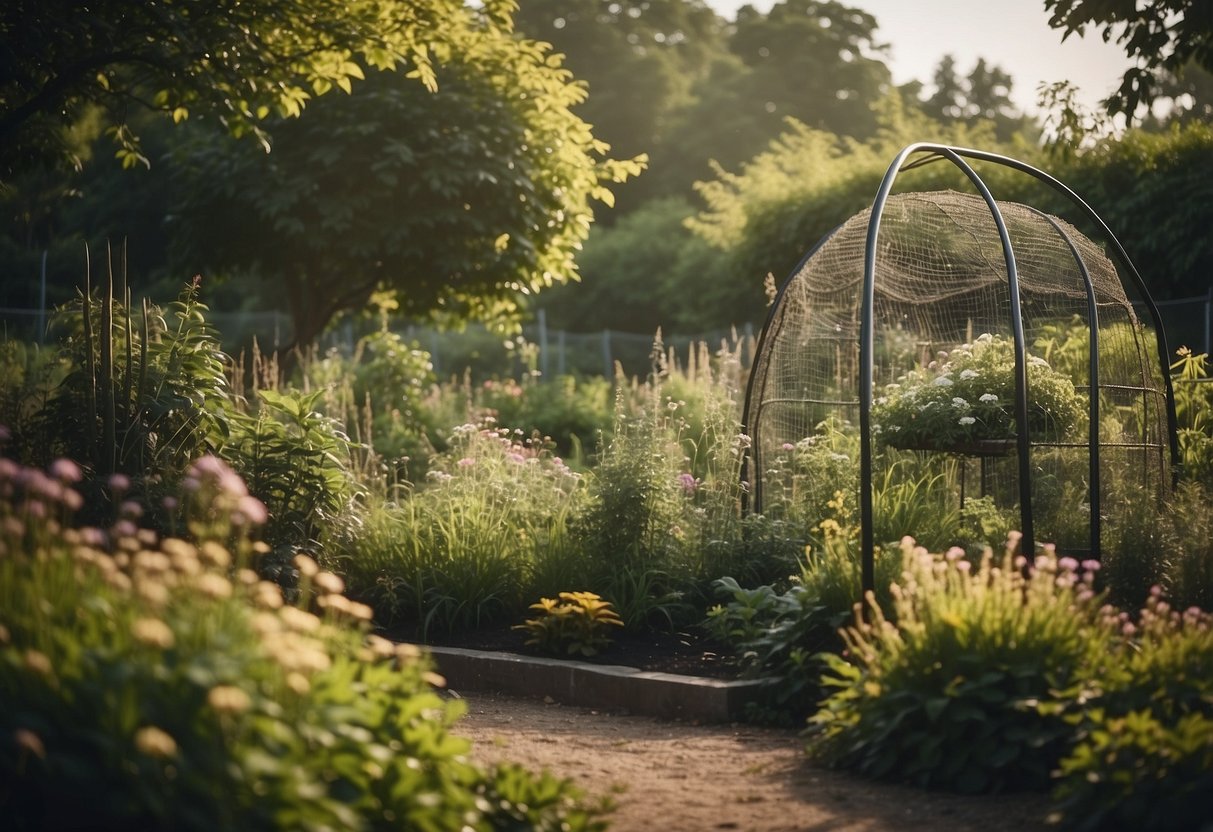
Garden netting is a great way to keep deer out.
Use netting that stands at least 7 to 8 feet high, as deer can jump quite high.
Ensure the mesh size is small enough to stop deer from getting tangled in it. This can protect other wildlife too.
Secure the netting firmly to the ground to prevent deer from pushing underneath. Read more about effective strategies for protecting your garden.
10) Place Scented Soap Bars

Using scented soap bars, like Irish Spring, can help keep deer out of your garden. The strong smell of the soap is something deer dislike.
Cut the bar soap into pieces and place them in mesh bags. Hang these bags near the plants deer like to munch on.
You can also dissolve the soap in water and spray it on the plants. The smell should help keep the deer away.
Understanding Deer Behavior

Knowing why and when deer come into your garden can help you protect it. Deer are attracted to certain plants and become more active during particular seasons.
Why Deer Visit Gardens
Deer visit gardens mainly in search of food. They are especially drawn to gardens with tender plants like hosta, tulips, and vegetables. These plants are easy for deer to eat and provide a rich source of nutrients. Gardens that are near woods or natural areas are more likely to have deer problems because deer prefer habitats with cover and access to food.
To deter deer, avoid planting their favorite foods. Instead, choose deer-resistant plants such as lavender, marigolds, or daffodils. Installing barriers or using repellent sprays can add extra layers of protection. Deer have keen senses, so they will notice changes that make your garden less inviting.
Peak Seasons for Deer Activity
Deer activity peaks during certain seasons due to mating, birthing, and weather conditions. In the spring, deer are more active because they are searching for food after a long winter. This is also when new plants start to grow, making gardens particularly attractive. In the fall, deer move around more as they prepare for the winter and the rut (mating season) begins.
During these peak times, it’s essential to stay vigilant. Keep your garden prepared with deterrents like fences or motion-activated lights. Understanding the seasonal patterns can help you anticipate and prevent deer damage effectively.
Deer-Resistant Plants

Using deer-resistant plants can effectively keep deer away from your garden. These plants are less appealing to deer due to their scent, taste, or texture, providing a valuable solution for gardeners.
Popular Deer-Resistant Perennials
Foxglove: Foxglove’s tall flower spikes can reach up to 8 feet, making them a striking addition to perennial borders. They thrive in soil with a pH of 5.5-7.0 and can add height and charm to your garden (Southern Living).
Bee Balm: Known for attracting pollinators, bee balm is rarely touched by deer due to its strong fragrance. It can grow 1 to 4 feet tall and is suitable for zones 3-9, thriving in full sun to partial shade (Garden Design).
Lavender: Lavender’s strong scent keeps deer at bay while adding beauty and fragrance to your garden. It’s also useful for various culinary and medicinal purposes (Get Busy Gardening).
Using Native Plants to Deter Deer
Lemongrass: Native to more tropical regions, lemongrass emits a citrusy scent that deer find unappealing. It can also be used in cooking and natural insect repellents (Get Busy Gardening).
Marjoram: This herb is another excellent choice, with a strong aroma that deters deer. It’s low-maintenance and flourishes in various climates, enriching your garden with its scent and flowers (Get Busy Gardening).
Cilantro: Known for its pungent smell, cilantro is rarely bothered by deer. It’s also beneficial in the kitchen, adding flavor to many dishes (Get Busy Gardening).
Physical Barriers and Fencing
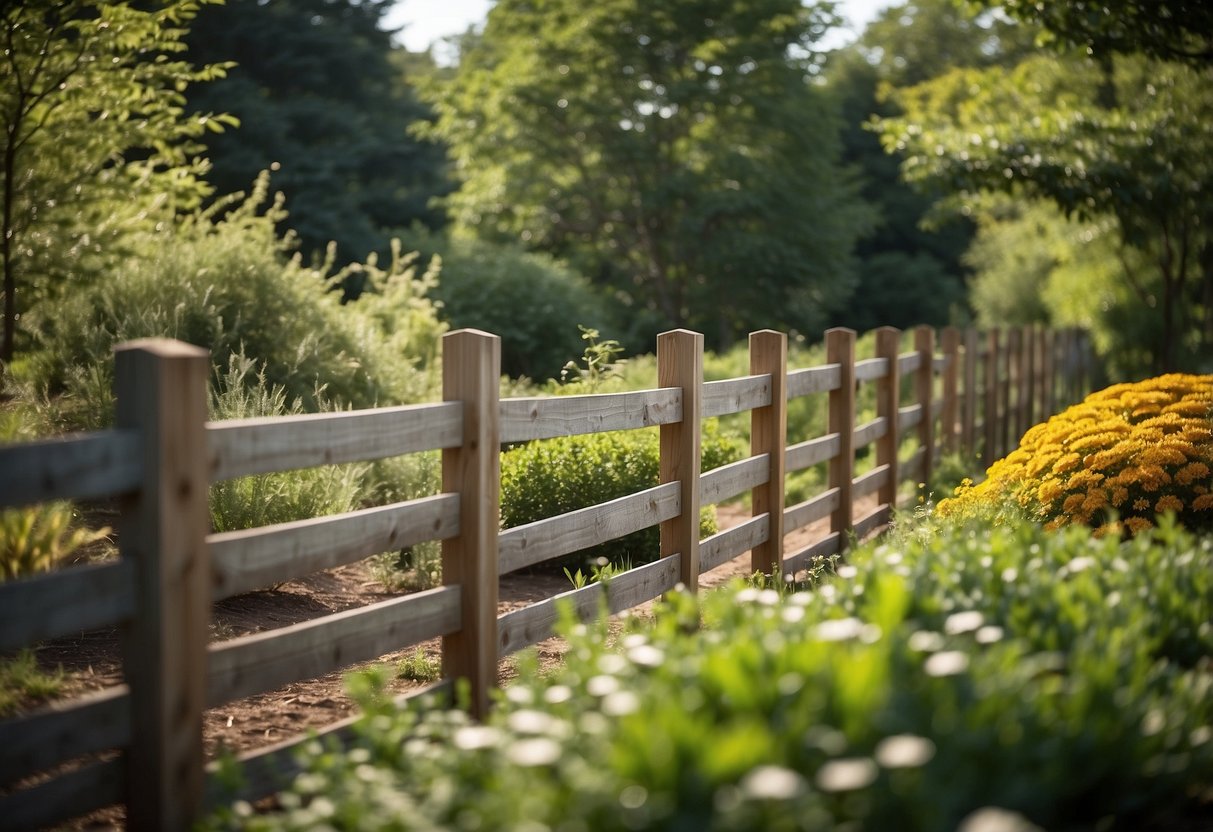
Creating physical barriers and fencing are key strategies to keep deer out of your garden. Learn about the most effective fence designs and how to blend them seamlessly into your garden’s layout.
Effective Fence Designs
One great way to keep deer out is using tall fences. An 8-foot fence is usually high enough to prevent deer from jumping over. These fences can be made of various materials like wood, metal, or plastic mesh.
Plastic or wire mesh fencing is a budget-friendly option, costing between $0.85 to $3.10 per linear foot. To install, you’ll need metal T-bar posts to hold the fence in place. This setup can be completed in a day for a 100-foot fence, costing between $350 to $600 for both materials and labor.
Electric fences are another option but may have zoning restrictions, so always check your local laws first. Electric fences can be very effective if allowed, providing a deterrent without obstructing views.
Integrating Fencing with Garden Design
When planning your garden, it’s important to make fencing visually appealing. One approach is using a nearly invisible mesh, like polypropylene mesh. This type of mesh blends into the surroundings and maintains the natural look of your garden.
You can also incorporate the fence into the landscape by using climbing plants. Vines and flowers can cover the fence, making it a part of the garden scenery. This not only provides a deterrent but also enhances the garden’s aesthetic.
If you have a driveway or other entry points, consider adding cattle guards to prevent deer from entering through unfenced areas. This way, you secure your garden without compromising the overall appearance.







